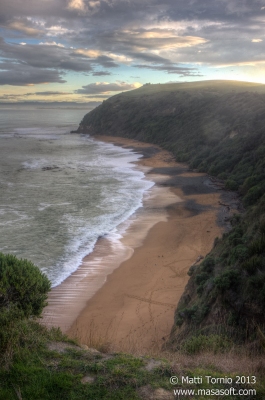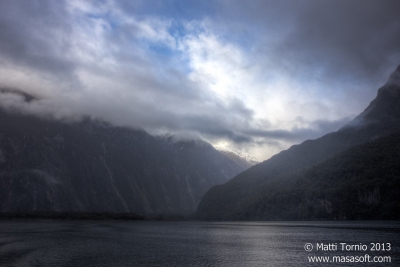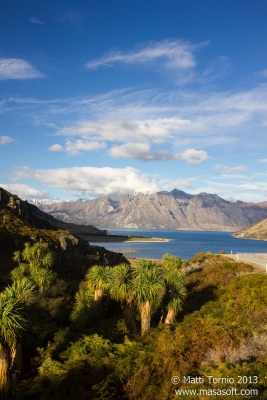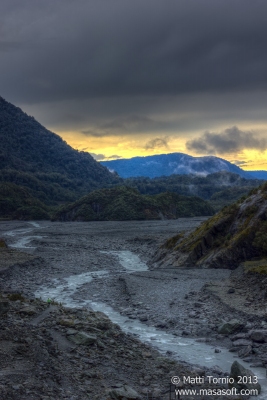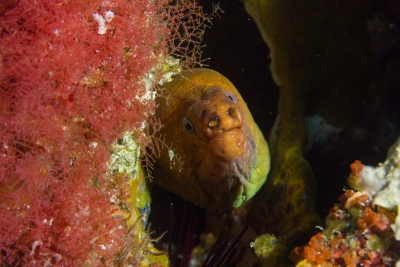After Te Anau and Milford Sound it was time to leave the West Coast and drive across the country to the more populated East Coast.
As we had a long day ahead of us we got up early in the morning. Soon enough we caught a pretty sunrise over some hills which definitely warranted a quick stop for some stops. Sadly there wasn’t much else to see during the inland crossing. Luckily New Zealand is not a wide country and soon enough we were on the other coast. While we didn’t really have time to properly explore this part of New Zealand we still wanted to do a short sidetrip to the Catlins. This sparsely populated region is excellent for wildlife encounters and some awesome scenery. After the rainy Milford the weather was a big improvement too, sunny and quite warm.
After reaching the town of Balclutha we turned off the main road and followed a rather small road down to the coast. Along the way we passed the small coastal village of Kaka Point and then reached our main destination, the Nugget Point. This is one of the iconic landmarks in this part of New Zealand. After a shortish walk we reached a small lighthouse at the of the steep headland. The headland is surrounded by numerous small islets, the actual “nuggets”. It’s also an excellent spot to observe the countless birds living in the area.
There’s also a penguin colony nearby but sadly at this time of the day all of them were out in the sea. The area is also popular hanging spot for seals and sea lions and we actually spotted a lone sea lion bull on the beach just after Kaka Point. Sadly he plunged back into the ocean before any of us was able to take a photo.
All in all this sidetrip was a big success even if Jacinta had to skip some of the longer walks as she wasn’t feeling too well.
After a quick picnic stop in Balclutha we started driving north along the coast towards Dunedin and eventually Oamaru, our stop for the night. Dunedin is the main city in this area and an important cultural center in New Zealand. The area also has numerous opportunities for observing the rich wildlife along the coast. Sadly we didn’t have time for a stop there, as we had to get to Oamaru before sunset to observe the penguins there.
We did have one stop along the way at the Moeraki Boulders. This part of the coast is a rather curious sight as erosion has formed large spherical boulders. Many of them look almost like eggs of some giant creature!
Our final stop of the day was Oamaru, one of the few places in New Zealand with both a blue penguin and a rare yellow-eyed penguin in close proximity. As all of us had already seen the blue penguins or little penguins as they are usually known in Australia, we focused on the other colony. Like little penguins the yellow-eyed penguins spend the day out on the sea hunting for food and return to their colony for the night. They do keep slightly more convenient hours though and generally return an hour or two before the sunset already.
The yellow-eyed penguins (or Hoiho as they are also known) are quite rare with an estimated population of only 4000. Along the coastline there are various hides where you can observe the colonies without disturbing the birds. In Oamaru the penguins can be observed from the cliffs above the colony. Sadly this meant we were quite a distance from the penguins so they are appear rather tiny even on my 300 mm lens.
Winter is usually the worst time to observe the birds as they tend to be lot more numerous over the summer months. We were still able to spot quite a few penguins wading in. Even if quite a few times it may have been the same birds as the penguins kept going out again while looking for their own nests!
After the penguins we spent some time in Oamaru itself. There’s a large blue penguin colony in the harbour area, but we decided not to take the tour. Instead we spent some time enjoying the pretty sunset nearby.
But Jacinta and I hadn’t had quite enough of the penguins yet, so we got up really early in the morning for another chance of spotting the Hoiho. Good thing we did too, we got treated to a magnificent sunrise and saw quite a few penguins leaving their nests too. And to make it even better there was also a seal family hanging out on the beach, too!
After this great experience it was time to start heading back towards Christchurch as our return flight was leaving really early on the following morning.
We did a couple of quick stops along the way and then got back to Christchurch itself where we visited a nice Sunday market. Jacinta and I also did some walking in the Botanic Gardens and then all three of us met up for another Light up the Leafy Night event in the gardens. This was a rather pleasant way to finish up the trip!
After a nice dinner and a few hours of sleep we drove down to the airport and caught an early flight back to Melbourne. Sadly my cold was getting quite nasty at this point, but it was too late to spoil an excellent trip!





